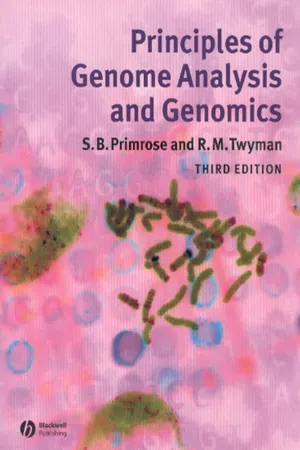
- English
- PDF
- Available on iOS & Android
Principles of Genome Analysis and Genomics
About This Book
With the first draft of the human genome project in the public domain and full analyses of model genomes now available, the subject matter of 'Principles of Genome Analysis and Genomics' is even 'hotter' now than when the first two editions were published in 1995 and 1998. In the new edition of this very practical guide to the different techniques and theory behind genomes and genome analysis, Sandy Primrose and new author Richard Twyman provide a fresh look at this topic. In the light of recent exciting advancements in the field, the authors have completely revised and rewritten many parts of the new edition with the addition of five new chapters. Aimed at upper level students, it is essential that in this extremely fast moving topic area the text is up to date and relevant.
- Completely revised new edition of an established textbook.
- Features new chapters and examples from exciting new research in genomics, including the human genome project.
- Excellent new co-author in Richard Twyman, also co-author of the new edition of hugely popular Principles of Gene Manipulation.
- Accompanying web-page to help students deal with this difficult topic at www.blackwellpublishing.com/primrose
Frequently asked questions
Information
Table of contents
- Preface
- Abbreviations
- CHAPTER 1 Setting the scene: the new science of genomics
- Introduction
- Physical mapping of genomes
- Sequencing whole genomes
- Bene •ts of genome sequencing
- Outline of the rest of the book
- Terminology
- Keeping up to date
- Suggested reading
- Useful websites
- CHAPTER 2 The organization and structure of genomes
- Introduction
- Genome size
- Sequence complexity
- Introns and exons
- Genome structure in viruses and prokaryotes
- The organization of organelle genomes
- The organization of nuclear DNA in eukaryotes
- Suggested reading
- Useful websites
- CHAPTER 3 Subdividing the genome
- Introduction
- Fragmentation of DNA with restriction enzymes
- Separating large fragments of DNA
- Isolation of chromosomes
- Chromosome microdissection
- Vectors for cloning DNA
- Yeast arti •cial chromosomes
- P1-derived and bacterial arti •cial chromosomes as alternatives to yeast arti •cial chromosomes
- Retro •tting
- Choice of vector
- Suggested reading
- Useful website
- CHAPTER 4 Assembling a physical map of the genome
- Introduction
- Restriction enzyme •ngerprinting
- Marker sequences
- Hybridization assays
- Physical mapping without cloning
- Integration of different mapping methods
- Suggested reading
- Useful websites
- CHAPTER 5 Sequencing methods and strategies
- Basic DNA sequencing
- Modi •cations of chain-terminator sequencing
- Automated DNA sequencing
- DNA sequencing by capillary array electrophoresis
- Basecalling and sequence accuracy
- High throughput sequencing
- Sequencing strategies
- Alternative DNA sequencing methodologies
- Suggested reading
- Useful websites
- CHAPTER 6 Genome annotation and bioinformatics
- Introduction
- Traditional routes to gene identi •cation
- Databases
- Overview of sequence analysis
- Detecting open-reading frames
- Software programs for •nding genes
- Using homology to •nd genes
- Analysis of non-coding RNA and extragenic DNA
- Identifying the function of a new gene
- Secondary databases of functional domains
- Gene ontology
- Analyses not based on homology
- Genome annotation
- Molecular phylogenetics
- Suggested reading
- Useful websites
- CHAPTER 7 Comparative genomics
- Introduction
- Orthologues,paralogues and gene displacement
- Protein evolution by exon shuf •ing
- Comparative genomics of prokaryotes
- Comparative genomics of organelles
- Comparative genomics of eukaryotes
- Other aspects of comparative genomics
- Suggested reading
- Useful websites
- CHAPTER 8 Protein structural genomics
- Introduction
- Determining gene function by sequence comparison
- Determining gene function through conserved protein structure
- Approaches to protein structural genomics
- Suggested reading
- Useful website
- CHAPTER 9 Global expression pro •ling
- Introduction
- Traditional approaches to expression pro •ling
- Global analysis of RNA expression
- Global analysis of protein expression
- Suggested reading
- Useful websites
- CHAPTER 10 Comprehensive mutant libraries
- Introduction
- High-throughput systematic gene knockout
- Genome-wide random mutagenesis
- Suggested reading
- Useful websites
- CHAPTER 11 Mapping protein interactions
- Introduction
- Methods for protein interaction analysis
- Library-based methods for screening protein interactions
- Informatics tools and resources for protein interaction data
- Suggested reading
- Useful websites
- CHAPTER 12 Applications of genome analysis and genomics
- Introduction
- Theme 1:Understanding genetic diseases of humans
- Theme 2:Understanding responses to drugs (pharmacogenomics)
- Theme 3:Understanding and combatting bacterial pathogenicity
- Theme 4:Getting to grips with quantitative traits
- Theme 5:The impact of genomics on agriculture
- Theme 6:Developmental genomics
- Suggested reading
- References
- Index